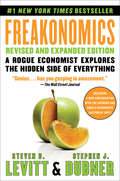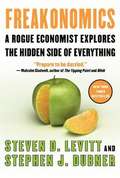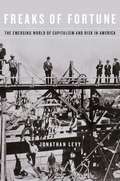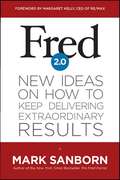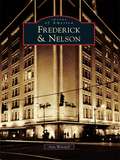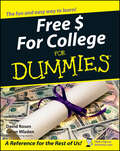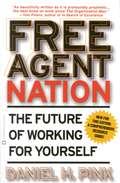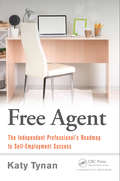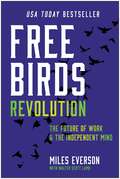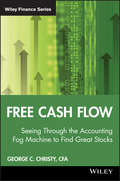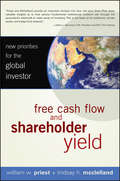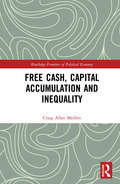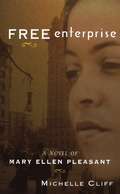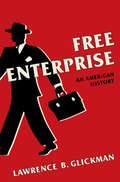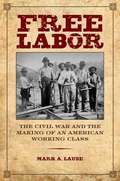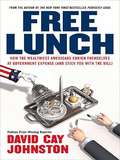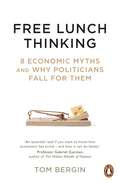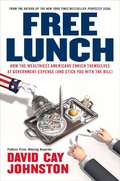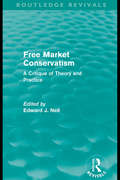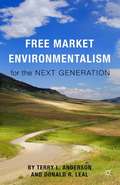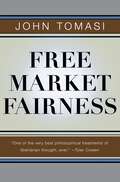- Table View
- List View
Freakonomics Rev Ed: A Rogue Economist Explores the Hidden Side of Everything
by Stephen J. Dubner Steven D. LevittWhich is more dangerous, a gun or a swimming pool? What do schoolteachers and sumo wrestlers have in common? Why do drug dealers still live with their moms? How much do parents really matter? How did the legalization of abortion affect the rate of violent crime? These may not sound like typical questions for an econo-mist to ask. But Steven D. Levitt is not a typical economist. He is a much-heralded scholar who studies the riddles of everyday life-from cheating and crime to sports and child-rearing-and whose conclusions turn conventional wisdom on its head. Freakonomics is a groundbreaking collaboration between Levitt and Stephen J. Dubner, an award-winning author and journalist. They usually begin with a mountain of data and a simple question. Some of these questions concern life-and-death issues; others have an admittedly freakish quality. Thus the new field of study contained in this book: freakonomics. Through forceful storytelling and wry insight, Levitt and Dubner show that economics is, at root, the study of incentives-how people get what they want, or need, especially when other people want or need the same thing. In Freakonomics, they explore the hidden side of . . . well, everything. The inner workings of a crack gang. The truth about real-estate agents. The myths of campaign finance. The telltale marks of a cheating schoolteacher. The secrets of the Klu Klux Klan. What unites all these stories is a belief that the modern world, despite a great deal of complexity and downright deceit, is not impenetrable, is not unknowable, and-if the right questions are asked-is even more intriguing than we think. All it takes is a new way of looking. Freakonomics establishes this unconventional premise: If morality represents how we would like the world to work, then economics represents how it actually does work. It is true that readers of this book will be armed with enough riddles and stories to last a thousand cocktail parties. But Freakonomics can provide more than that. It will literally redefine the way we view the modern world.
Freakonomics: A Rogue Economist Explores the Hidden Side of Everything
by Stephen J. Dubner Steven D. LevittIn Freakonomics (written with Stephen J. Dubner), Levitt argues that many apparent mysteries of everyday life don't need to be so mysterious: they could be illuminated and made even more fascinating by asking the right questions and drawing connections. Economics can explain a lot of real world every day situations.
Freaks of Fortune
by Jonathan LevyUntil the nineteenth century, risk was a specialized term: it was the commodity exchanged in a marine insurance contract. Freaks of Fortune tells how the modern concept of risk emerged in the United States. Born on the high seas, risk migrated inland and became essential to the financial management of an inherently uncertain capitalist future.
Fred 2.0: New Ideas on How to Keep Delivering Extraordinary Results
by Mark SanbornNine years ago, bestselling author and business consultant Mark Sanborn introduced the world to Fred, his postman, who delivered extraordinary service in simple but remarkable ways. Fred’s story inspired millions. Companies―even, cities―were inspired to turn the ordinary into the extraordinary each day. Today, with stiff competition from the networked global economy, delivering extraordinary results is more important than ever. With Fred 2.0, Mark not only revisits the original Fred to gain new insights, but also equips all of us with new strategies to achieve more. You’ll not only be inspired by Fred 2.0, you’ll also have the tools and strategies to aim higher and achieve the extraordinary.
Fred Henderson
by John P. KotterFocuses on the management style of Fred Henderson in the context of a relatively stable business environment within Xerox Corporation. To be contrasted with the case, Renn Zaphiropoulos and the videotape, A Day with Renn Zaphiropoulos (9-881-501), which are appropriate for a more dynamic environment.
Fred Khosravi and AccessClosure
by Liz Kind Richard G. HamermeshFred Khosravi is a serial medical device entrepreneur. In his latest venture, he must decide whether to sell now or continue to develop his current product and whether to market it, sell the company, or IPO.
Fred Khosravi and AccessClosure (B)
by Lauren Barley Richard G. HamermeshIt was January 2013, and Fred Khosravi, chairman of the board of AccessClosure Inc., wondered what the new year had in store for him and AccessClosure, the company he founded in late 2002. Khosravi was cautiously optimistic-the Mountain View, California-based medical device company had been cash flow positive for seven consecutive quarters with annual revenues over $70 million. Since 2007, it had shipped well over 1.5 million of its vascular closure device (VCD), the Mynx, which was stocked in more than 1,200 catheter labs worldwide. However, a 2008 patent infringement lawsuit filed by St. Jude Medical, the VCD market leader, loomed large. The case was on appeal, and a three-judge panel would hear arguments in March 2013. If AccessClosure lost its appeal, it faced a $27.1 million judgment for patent infringement and a permanent injunction from selling its Mynx family of VCDs, its sole source of revenue.
Fred Khosravi and AccessClosure (C)
by Lauren Barley Richard G. HamermeshOn September 11, 2013, the three-judge panel of the U.S. Court of Appeals for the Federal Circuit denied St. Jude's request to rehear an appeal on the "double patenting" ruling for the '439 patent. Further, it removed the injunction threat that was hanging over the company. The future looked bright for AccessClosure as 2013 drew to a close. The company expected 2014 revenues of more than $100 million with a gross margin of greater than 70%. It was also anticipating FDA approval on a significant product improvement within the next several months.
Frederick & Nelson
by Ann WendellIn 1890, D. E. Frederick arrived in Seattle and, joined soon after by Nels Nelson, started what would become one of the Northwest's best-loved and well-regarded stores. For more than 100 years, Frederick & Nelson was much more than just a department store to the people of Seattle--it was an icon. F&N, as locals referred to it, established the city's retailcore, led the war-bond drive, acted as a civic booster, and pioneered a high level of benefits for its workers. But it was the customer experience that made all the difference at F&N. Whether it was a fashion show in the Tea Room, a visit to Santa, or the taste of a Frango, the memories of Frederick & Nelson still resonate today throughout the Pacific Northwest.
Free $ For College For Dummies
by David Rosen Caryn MladenDemystifies the scholarship selection process Write winning essays and get financial aid Need money for college? This simple, straightforward guide shows you how to find scholarships, grants, and other "free money" to use toward your college expenses. You get expert advice on applying for federal grants, participating in state tuition plans, competing for scholarships from private organizations, and more - with tips on avoiding scams, completing your applications on time, and finding financial aid from unlikely sources. The Dummies Way * Explanations in plain English * "Get in, get out" information * Icons and other navigational aids * Tear-out cheat sheet * Top ten lists * A dash of humor and fun
Free Agent Nation: How America's New Independent Workers Are Transforming the Way We Live
by Daniel H. PinkThis book examines the shift in attitudes and patterns of work in the modern world.
Free Agent: The Independent Professional's Roadmap to Self-Employment Success
by Katy TynanThere is a seismic shift underway in the employer/employee relationship that is redefining the nature of jobs and careers. Sole proprietors and independent contractors now represent more than 20 percent of the workforce, and that number is expected to reach nearly 50 percent within the next 10 years.Despite the proliferation of people engaging in f
Free Birds Revolution: The Future of Work and the Independent Mind
by Miles EversonBOOKSCAN BUSINESS BESTSELLER PUBLISHERS WEEKLY BESTSELLER USA TODAY BESTSELLERFor both independent professionals and corporate executives, this educational and practical guide unpacks the ever-growing workforce and offers leaders crucial ways to become its client of choice.From iconic entertainers like Taylor Swift, Bob Dylan, and Sylvester Stallone to innovators like Steve Jobs and Bill Gates, the world of music and business has always thrived on independence and creativity. Now, this same spirit is transforming the workforce. Free Birds Revolution is your guide to navigating this seismic shift. Packed with stories from pop culture and entrepreneurial icons, Everson reveals how the independent workforce is reshaping the future of work. Inside, you'll discover: The Six Forces Shaping the Future of Work: Explore the unstoppable &“Everson Evolutions&” driving the rise of independent professionals. The Death of Employer-Employee Loyalty: Understand how the social contract is evolving and what it means for businesses and workers alike. The Motivation to Fly Solo: Discover why more professionals are choosing independence and how your business can attract top talent. Becoming a Free Bird: Embrace your own independent spirit and take control of your career. Free Birds Revolution is essential reading for anyone ready to redefine their work life. Whether you&’re a solopreneur or a business leader, this book will help you thrive in the dynamic landscape of independent work. Join the revolution and let your career take flight.
Free Cash Flow
by Christy George C.The purpose of this book is to explain Free Cash Flow and how to use it to increase investor return. The author explains the differences between Free Cash Flow and GAAP earnings and lays out the disadvantages of GAAP EPS as well as the advantages of Free Cash Flow. After taking the reader step-by-step through the author's Free Cash Flow statement, the book illustrates with formulas how each of the four deployments of Free Cash Flow can enhance or diminish shareholder return. The book applies the conceptual building blocks of Free Cash Flow and investor return to an actual company: McDonald's. The reader is taken line-by-line through the author's investor return spreadsheet model: (1) three years of McDonald's historical financial statements are modeled; (2) a one-year projection of McDonald's Free Cash Flow and investor return is modeled. Five other restaurant companies are compared to McDonald's and each other using both Free Cash Flow and GAAP metrics.
Free Cash Flow and Shareholder Yield
by Mcclelland William W. Priest Lindsay H.Praise for Free Cash Flow and Shareholder Yield "Free Cash Flow and Shareholder Yield provides a provocative solution to the profound paradigm shift now redefining valuation standards for markets around the globe. In commonsense terms, it defines how the investment community has begun the journey of shifting to the more dependable, robust metric of free cash flow. " -Rob Brown, Chief Investment Officer, Genworth Financial Asset Management, Inc. This graph tells a singularly compelling story of the changing order of the drivers of total equity returns. In Free Cash Flow and Shareholder Yield, you will learn how this story is the key to informed investing in an evolving global marketplace.
Free Cash, Capital Accumulation and Inequality (Routledge Frontiers of Political Economy)
by Craig Allan MedlenInvestment is the engine of growth. In consequence, the social welfare of the populace depends on the expectations of uncertain profitability as understood by the agents of a wealthy few who decide upon levels of investment. As private wealth is intimately tied to the investment process, the importance of wealth concentration goes far beyond considerations of equity. In recent years, private economic power has become increasingly concentrated as more of the population has become dependent upon an elite pursuing private ends. In this context, this book examines the role of capital accumulation in various historical contexts. Over seventy years ago, Michal Kalecki derived the mathematical relationship between government deficits, the external trade account and free cash—defined as the gross profit over and above that portion ploughed back into new investment. Since then, the free cash literature has remained largely within an industrial organizational context where free cash theory has helped to explain mergers. In contrast, this book, revisits Kalecki’s free cash construction at the macro and global level and explores the various causes and effects of free cash on the economy. As part of this examination, the author highlights the historical uses of free cash in imperialist adventures, mergers and speculative endeavours. In addition to developing a new relative valuation measure of capital accumulation, he also utilizes a neo-Kaleckian model to help explain the U.S. slowdown in investment since the late 1960s, the increasing inequality of wealth and income and the recent speculative episodes associated with the spillage of free cash. Finally, based on these models the book argues for heightened taxes on the wealthy and an increased role for government investment in health care and energy. Free Cash, Capital Accumulation and Inequality offers an explanation as to how wealth and income inequalities have fashioned, and been fashioned by, various historical episodes right up to the present. It will be of great interest to those studying and researching in the field of economic analysis.
Free Enterprise: A Novel of Mary Ellen Pleasant
by Michelle CliffIn 1858, two black women meet at a restaurant and begin to plot a revolution. Mary Ellen Pleasant owns a string of hotels in San Francisco that secretly double as havens for runaway slaves. Her comrade, Annie, is a young Jamaican who has given up her life of privilege to fight for the abolitionist cause. Together they join John Brown's doomed enterprise and barely escape with their lives. With mesmerizing skill, Cliff weaves a multitude of voices into a gripping, poignant story of the struggle for liberation that began not long after the first slaves landed on America's shores.
Free Enterprise: An American History
by Lawrence B. GlickmanAn incisive look at the intellectual and cultural history of free enterprise and its influence on American politics Throughout the twentieth century, “free enterprise” has been a contested keyword in American politics, and the cornerstone of a conservative philosophy that seeks to limit government involvement into economic matters. Lawrence B. Glickman shows how the idea first gained traction in American discourse and was championed by opponents of the New Deal. Those politicians, believing free enterprise to be a fundamental American value, held it up as an antidote to a liberalism that they maintained would lead toward totalitarian statism. Tracing the use of the concept of free enterprise, Glickman shows how it has both constrained and transformed political dialogue. He presents a fascinating look into the complex history, and marketing, of an idea that forms the linchpin of the contemporary opposition to government regulation, taxation, and programs such as Medicare.
Free Labor: The Civil War and the Making of an American Working Class
by Mark A. LauseMonumental and revelatory, Free Labor explores labor activism throughout the country during a period of incredible diversity and fluidity: the American Civil War. Mark A. Lause describes how the working class radicalized during the war as a response to economic crisis, the political opportunity created by the election of Abraham Lincoln, and the ideology of free labor and abolition. Grappling with a broad array of organizations, tactics, and settings, Lause portrays not only the widely known leaders and theoreticians, but also the unsung workers who struggled on the battlefield and the picket line. His close attention to women and African Americans, meanwhile, dismantles notions of the working class as synonymous with whiteness and maleness. In addition, Lause offers a nuanced consideration of race's role in the politics of national labor organizations, in segregated industries in the border North and South, and in black resistance in the secessionist South, creatively reading self-emancipation as the largest general strike in U.S. history.
Free Lunch
by David Cay JohnstonThe bestselling author of Perfectly Legal returns with a powerful new exposé How does a strong and growing economy lend itself to job uncertainty, debt, bankruptcy, and economic fear for a vast number of Americans? Free Lunch provides answers to this great economic mystery of our time, revealing how today?s government policies and spending reach deep into the wallets of the many for the benefit of the wealthy few. Johnston cuts through the official version of events and shows how, under the guise of deregulation, a whole new set of regulations quietly went into effect? regulations that thwart competition, depress wages, and reward misconduct. From how George W. Bush got rich off a tax increase to a $100 million taxpayer gift to Warren Buffett, Johnston puts a face on all of the dirty little tricks that business and government pull. A lot of people appear to be getting free lunches?but of course there?s no such thing as a free lunch, and someone (you, the taxpayer) is picking up the bill. Johnston?s many revelations include: ? How we ended up with the most expensive yet inefficient health-care system in the world ? How homeowners? title insurance became a costly, deceitful, yet almost invisible oligopoly ? How our government gives hidden subsidies for posh golf courses ? How Paris Hilton?s grandfather schemed to retake the family fortune from a charity for poor children ? How the Yankees and Mets owners will collect more than $1. 3 billion in public funds In these instances and many more, Free Lunch shows how the lobbyists and lawyers representing the most powerful 0. 1 percent of Americans manipulated our government at the expense of the other 99. 9 percent. With his extraordinary reporting, vivid stories, and sharp analysis, Johnston reveals the forces that shape our everyday economic lives?and shows us how we can finally make things better. .
Free Lunch Thinking: 8 Economic Myths and Why Politicians Fall for Them
by Tom BerginCountries with smaller governments grow faster.Tobacco taxes are the best way to cut smoking. Government regulation discourages entrepreneurship.Award-winning investigative journalist Tom Bergin digs into eight mantras widely accepted by Western governments and, by talking to the people who promote those ideas and the workers, businesspeople and consumers who have felt their impacts, finds they often don't play out as expected. Smart, funny and incisive, Free Lunch Thinking is essential reading for anyone who really wants to know how economies tick - and why they often don't._______________________________________________________________'I couldn't put it down. A thorough and nuanced examination of the evolution of supply side economics . . . I loved it.' Arthur Laffer, creator of the Laffer Curve'An entertaining and thought-provoking exploration of economic theories that have been both widely accepted and largely wrong . . . I devoured it in a couple of sittings.' Reuters Breakingviews'An insightful account of the recent history of economic thought. If you are looking for a book which challenges you without being annoying - make it this one.' Institute of Economics Affairs
Free Lunch: How the Wealthiest Americans Enrich Themselves at Government Expense (and Stick You with the Bill)
by David Cay JohnstonJohnston shows how, under the guise of deregulation, a new set of regulations went into effect, that thwart competition, depress wages and reward misconduct.
Free Market Conservatism: A Critique of Theory & Practice (Routledge Revivals)
by Edward NellFirst published in 1984, this book carefully dissects and convincingly demonstrates that conservative economics is incoherent in theory and disastrous in practice. The three main schools of thought supporting "free-market" policies – supply side economics, monetarism and rational expectations – are examined in turn and each is found defective. Three case studies of conservative policy in action follow: Reagan’s U.S., Thatcher’s U.K. and Pinochet’s Chile and their courses are charted in depth. In addition, Robert Heilbroner and Edward Nell analyse economic conservatism’s ideology and social policy, and the book concludes with an assessment of the political reasons for the continuing appeal of free-market conservatism despite its theoretical incoherence and practical failure. This is a careful and comprehensive look at this subject which tackles both the theory and the practice head-on. It will make useful and stimulating reading for students of economics and political economy on courses of economic policy and macro-economics and in addition will be of keen interest to all those involved in the debate about one of the major policy issues of our time.
Free Market Environmentalism for the Next Generation
by Terry L. Anderson Donald R. LealThis book provides a vision for environmentalism's future, based on the success of environmental entrepreneurs around the world. The work provides the next generation of environmental market ideas and the chapters are co-authored with young scholars and policy analysts who represent the next generation of environmental leaders.
Free Market Fairness
by John TomasiA provocative new vision of free market capitalism that achieves liberal ends by libertarian meansCan libertarians care about social justice? In Free Market Fairness, John Tomasi argues that they can and should. Drawing simultaneously on moral insights from defenders of economic liberty such as F. A. Hayek and advocates of social justice such as John Rawls, Tomasi presents a new theory of liberal justice. This theory, free market fairness, is committed to both limited government and the material betterment of the poor. Unlike traditional libertarians, Tomasi argues that property rights are best defended not in terms of self-ownership or economic efficiency but as requirements of democratic legitimacy. At the same time, he encourages egalitarians concerned about social justice to listen more sympathetically to the claims ordinary citizens make about the importance of private economic liberty in their daily lives. In place of the familiar social democratic interpretations of social justice, Tomasi offers a "market democratic" conception of social justice: free market fairness. Tomasi argues that free market fairness, with its twin commitment to economic liberty and a fair distribution of goods and opportunities, is a morally superior account of liberal justice. Free market fairness is also a distinctively American ideal. It extends the notion, prominent in America's founding period, that protection of property and promotion of real opportunity are indivisible goals. Indeed, according to Tomasi, free market fairness is social justice, American style.Provocative and vigorously argued, Free Market Fairness offers a bold new way of thinking about politics, economics, and justice—one that will challenge readers on both the left and right.
